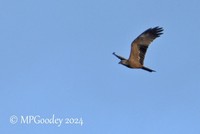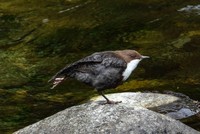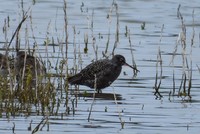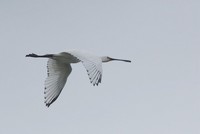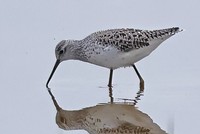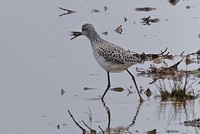Record-breaking wintering numbers of Spoon-billed Sandpipers in China
Record numbers of Spoon-billed Sandpiper, a Critically Endangered shorebird, have been discovered wintering in China, says conservationists from the Hong Kong Bird Watching Society (HKBWS, BirdLife International Partner in China).
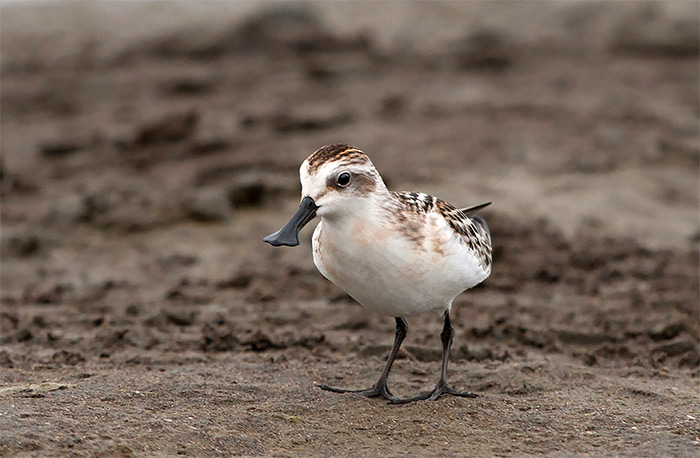
On 30 December 2015, HKBWS volunteers Jonathan Martinez and John Allcock found at least 30 Spoon-billed Sandpipers near the Fucheng Estuary in south-west Guangdong Province, some of this land is located within the Zhanjiang Mangrove National Nature Reserve. This was the highest number ever found in China during winter, but the record did not even last a month
At the end of January further coordinated counts in Guangdong Province, including members from the Zhanjiang Bird Watching Society and staff from the Zhanjiang Mangrove National Nature Reserve Management Bureau. Together they counted at least 45 individuals from a four locations, with Fucheng Estuary having the highest count (38 individuals).
Jonathan Martinez, commented: ”These numbers are a massive increase on just three individuals counted at Fucheng during our inaugural mid-winter survey in 2012. That year, we found long lines of mist-nets were found flanking shorebird roost sites. We counted hundreds of dead birds, and literally thousand of nets”.
Since then the Zhanjiang Bird Watching Society, and government officials from the Zhanjiang Forestry Department have taken sustained measures to clear the illegal mist nets. In addition, there were educational activities carried out by the Hong Kong Bird Watching Society and Zhanjiang Bird Watching Society to help raising awareness to the local communities.
“Our work has made Fucheng mudflat an attractive place for Spoon-billed Sandpiper and other waterbirds”, says Jonathan Martinez. The estuary in Fucheng is clearly of global importance for the species”.
Seven of the Guangdong birds were marked with coloured flags or rings on their legs. One of this was tagged with white leg flag engraved “MA”, this bird was also recorded last winter in the same place. The unique markings enable individual birds to be tracked as they travel along the East Asian—Australasian Flyway.
“As most of the individual birds found here are marked in Russia it also is becoming very important for development of cooperation conservation work along the lines of bilateral agreement on migratory birds signed by both the governments of China and Russia, for which SBS is the key model species”, said the Chair of the SBS Task Force Dr Evgeny Syroechkovskiy.
The global population of Spoon-billed Sandpiper numbers fewer than 400 adult birds. A large proportion were already known to use coastal wetlands in China whilst on passage between breeding grounds in Russia and principal wintering quarters in Bangladesh and Myanmar.
“With other known sites still to be surveyed we hope that further wintering Spoon-billed Sandpipers will be discovered in Guangdong and South China”, says Jonathan.
“This newly discovered wintering location is the third known biggest one in the world. This again proves exceptional importance of China for the survival of the whole Critically Endangered species”, commented Evgeny. The surveys were part of the international Spoon-billed Sandpiper Task Force winter census by Spoon-billed Sandpiper Task Force under EAAFP (East Asian-Australasian Flyway Partnership) between 26th January to 6th February, 2016.
BirdLife International
25 February 2016
The actions to stop the illegal trapping have been supported with a grant from the Critical Ecosystems Partnership Fund (CEPF).
BirdLife's Spoon-billed Sandpiper work has been helped by numerous supporters. Birdfair- Global Sponsor of the BirdLife Preventing Extinctions Programme, Heritage Expeditions, WildSounds, The Dutch Birding Association and VBN (BirdLife in the Netherlands), The David & Lucile Packard Foundation, Disney Friends for Change, The CMS Secretariat, The MBZ Foundation, Save Our Species, Ed Keeble and the many other generous individuals have all become BirdLife Species Champions or Programme Supporters under the BirdLife Preventing Extinctions Programme helping this species The Conservation breeding project is supported by WWT, RSPB, the UK Government’s Darwin Initiative and SOS – Save our Species, with additional financial contributions and support from BirdLife International, the East Asian— Australasian Flyway Partnership, the Convention on Migratory Species, Heritage Expeditions, the Australasian Wader Study Group of Birds Australia, the BBC Wildlife Fund, Avios, the Olive Herbert Charitable Trust, the Oriental Bird Club, British Airways Communities & Conservation Scheme, New Zealand Department of Conservation, the Queensland Wader Study Group, New South Wales Wader Study Group, Chester Zoo and many generous individuals.




